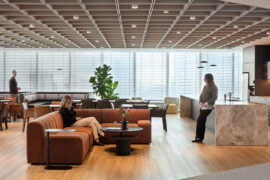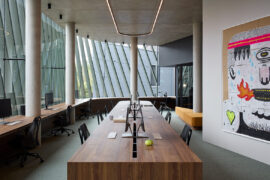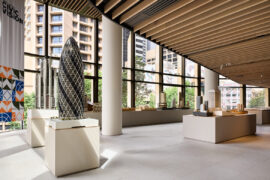On the eve of 2024, our new editor, Timothy Alouani-Roby, addresses an exciting yet provocative open letter to the Australian architecture community on the opportunities of an era.

The Bridge at Bundanon by Kirsten Thompson Architects, photograph by Zan Wimberley.
December 14th, 2023
I write to you, the design community of Australia and the Asia-Pacific, not in celebration but rather in anticipation of what might be. I think we might be standing on the precipice of a new golden age in architecture, a convergence of forces giving rise to a once-in-a-generation opportunity for something special. To be clear, these forces are about potential – they exist as opportunities in proportion with problems that are yet to be solved.
As the editor of Indesignlive, I want to sketch out some of the observations and ideas behind this thought – towards a manifesto for a world-leading Australian architecture. I think there are five pillars defining a uniquely opportune moment as we turn to a new year in 2024.

Country
Recently, attending the World Architecture Festival (WAF) in Singapore, I watched as Australian project after Australian project won awards, recognition and respect. As I noted in this article following discussions with architects on the ground at WAF, one striking feature of every single Australian presentation was the presence of Country and some acknowledgement of Indigenous history, culture or design. Australia is one of countless postcolonial countries represented on that global architectural stage but, as far as I saw, was the only one whose designers consistently centred Indigeneity in their projects.
The strength of engaging with Country as designers remains little more than a promise – we’re in the very early stages of truly coming to terms with what decolonisation might look and feel like in design. Australia might yet turn its back on a way forward, as it did with the referendum this year.
In a typically unjust colonial paradox, Australia’s brutal settler history creates a uniquely opportune juncture today. It’s a chance to heal precisely because there was such injury; a chance to enact significant justice precisely because the injustice was – and is – of such a magnitude. What can architecture do amidst this historical echo of violence?
It can, as a start, tell the world stories about the unique cultures of this land. As Alex Kibble of TKD Architects told me at WAF, “the reason [we’re talking about Indigeneity] is that in the last few years we’ve got to know a whole lot more about our culture. I’m not sure that the international audience fully understands what we’re talking about or why we’re talking about it, but we can only talk from our hearts on this and it’s important to us.”
The ”us” and the “we” in this must represent a will to listen, learn and enact. Let it be a privilege to design on Country, to have the opportunity to tap into millennia of knowledge and culture. If the non-Indigenous speaker is to use the plural “us”, it’s also a privilege that demands humility and comes with enormous responsibility. It’s the brilliance contained within the Welcome to Country and the reason why it makes racists so angry (‘how dare they welcome me to my own country’).

Place
It has its own subheading, but this and indeed every other pillar follows on in one way or another from Country. The other potential standout feature that I see as a common denominator in Australian architecture today is seeking a connection to place. This might seem like a facile thing to say, indeed most self-respecting architects make the claim in some manner. We must therefore be wary and critical.
What I have in mind with regard to Australian architecture and place, however, is that which it is not. I see fewer attempts to justify designs on the basis of the formal sublime – that is, fewer narratives about the funky shape and flamboyant form of a building. It remains the case elsewhere in the world; Cox Architecture’s Alastair Richardson recently told me that “we [in Australia] are not whimsical and we’re not into ‘statement’ architecture – I think we’re far more about trying to understand context, community and social life.”
I think instead of Woods Bagot’s office fit-out for M&C Saatchi accompanied by a rich narrative drawing on the history of Sydney’s sandstone and old waterways. I think of SJB’s eccentric and imaginative engagement with restricted urban space at 19 Waterloo Street, recognised at the INDE.Awards and as World Interior of the Year at WAF. I think of Kerstin Thompson Architects’ intervention at Bundanon that achieves monumentality and quietness at one and the same time, connecting to its surroundings through an ecologically holistic consciousness that does with materials what the landscape wants – less ‘what does the brick want to be’ and more ‘what does Country want it to be’.

I think of Kaunitz Yeung Architecture’s commitment to working in remote Aboriginal communities with sensitivity and care. I also think of what is an increasingly thought-provoking scene of architectural debate (more on that from us in 2024), perhaps best exemplified recently by fjcstudio’s panel talk events at The Mint or when Pritzker Prize-winners Lacaton & Vassal came to Sydney. Look too at what Australians such as Kevin Carmody are doing overseas.
Maybe it’s a nation of immigrants coming to terms with its fundamental rootlessness. The only choices in this land of extremes are, in 2024, extreme: find a way to connect with places or simply exist as nowhere-suburbs and soulless towers on the surface.

One foot in, one foot out
We’re a long way from the (perceived) centres of power. “Ausralia is at the end of the line,” as Alastair Richardson of Cox Architecture described it to me. “We have a sensibility that allows us a perspective that is very different to being at the heart of Europe, the USA or Asia – so we tend to have a better sense of oversight in terms of design. There’s a little bit of sensitivity about being at the end of the line and we seem to do things with purpose.”
AIA Gold Medallist Kerstin Thompson said “the reason I return [to WAF] is that it can take you out of your local bubble and remind you of the many parts of the world working under different conditions and offering new insights into architecture.” She’s absolutely right, of course, but the flipside is that Australia – on the margins geopolitically, one foot in the Anglophone world and the other stepping tentatively out into its own Asia-Pacific region – is positioned to do some uniquely interesting things.
Being both inside and outside can create the conditions for an explosion of creativity and difference. Australia is small enough to feel almost quaint or ‘personable’, yet large enough to generate the economies of scale needed for cutting-edge projects. It’s time to let go of the country’s chauvinistic side and embrace its far-flung, pseudo-peripheral position of multiple overlapping influences.
Cities and continents
Economically and politically, the decades-long shift in Australia tends towards more engagement with Asia. It’s a source of potentially great cultural riches – less outpost of the British Empire, more multicultural melting pot drawing on its diverse neighbours. Are Australian architects looking closely enough at trends in south-east Asia, China and India? What might a truly Asia-Pacific architecture – a hybrid architecture – look like and do differently to the rest of the world?
Part of Australia’s advantage today is found in its leading cities. Koichi Takada was telling me not long ago about how he couldn’t leave Sydney because it was green and just the right size, not too big and not too small. Like Melbourne and elsewhere, diverse populations harbour new ideas for design. As truly international cities with multicultural populations and high levels of prosperity, they are well placed for continued innovation in sectors such as workplace and hospitality design – not to mention innovation in multi-residential design, particularly the way that Austin Maynard Architects explain their design philosophy.

Sustainability?
Certainly, there remain deeply vested interests mitigating against meaningful climate action. Coal continues to be contested politically rather than despatched beyond the pale; opportunities for adaptive reuse continue to be missed; attitudes continue to deny. The Black Summer bushfires, however, raised the stakes, or at least brought the critical stakes already at play more firmly into the public consciousness.
With its prosperity, low population, access to abundant sources of renewable energy and vulnerability to heat and drought, Australia is almost uniquely placed to lead on climate action. We know how much of an impact construction and the built environment have on waste, and we know that the younger generations are increasingly angry and politicised over governmental inaction. This is the next generation of architects – if they can truly bring Country and climate together, there might finally be grounds for some optimism.

As editor at a longstanding publication, I want to celebrate the best of regional design. I also want to challenge architects. Everything discussed here is in a state of potentiality, not completeness: the pillars together present a unique moment to act within a context of crisis. If we miss this opportunity – the opportunity to develop an architecture that connects with place and acts on climate on the basis of Country – then an era of worsening crises will likely prevail instead.
Is Australian design ready to be truly introspective, self-critical, courageous and open? It has a chance to punch even further above its weight globally as the tired laggards of Europe and North America descend in the same old circles of vacuous talking points, entitlement and presumptuousness.
In 2024, let’s interrogate where we’re truly at. I’ll be delving into a series about the spaces between Australian and British architecture to get insights from renowned designers who have moved around in them. Let’s be critical, disagree, call out what is unhealthy and celebrate the work that is staking out a new, meaningful and just architecture.
“The old world is dying, and the new world struggles to be born,” said Antonio Gramsci. What role will Australian architects play in the birth pangs of the second quarter of the 21st century?
Join the debate – reach out with ideas here or here and let’s discuss them in 2024.
INDESIGN is on instagram
Follow @indesignlive
A searchable and comprehensive guide for specifying leading products and their suppliers
Keep up to date with the latest and greatest from our industry BFF's!

A curated exhibition in Frederiksstaden captures the spirit of Australian design

For Aidan Mawhinney, the secret ingredient to Living Edge’s success “comes down to people, product and place.” As the brand celebrates a significant 25-year milestone, it’s that commitment to authentic, sustainable design – and the people behind it all – that continues to anchor its legacy.

Buchan weaves heritage and contemporary retail across a 3,600sqm site featuring dual-branded hotels, arcades and revitalised laneways.

Smart Design Studio and Those Architects combine landmark and workplace in Bundarra, a Surry Hills gateway blending old and new.
The internet never sleeps! Here's the stuff you might have missed

Completed in 2025, Marella by Mosaic is a 30-storey residential tower in Broadbeach designed by Plus Studio. The project brings sculptural form, ocean views and hotel-style amenities together in a refined expression of coastal living.

Civic Vision, a major exhibition showcasing the global work of Foster + Partners, has officially opened in Sydney.
Please note: by submitting this form you will be added to the Indesignlive.com mailing list.